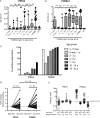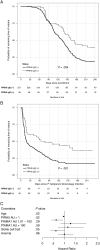Naturally acquired antibodies specific for Plasmodium falciparum reticulocyte-binding protein homologue 5 inhibit parasite growth and predict protection from malaria
- PMID: 24133188
- PMCID: PMC3923542
- DOI: 10.1093/infdis/jit553
Naturally acquired antibodies specific for Plasmodium falciparum reticulocyte-binding protein homologue 5 inhibit parasite growth and predict protection from malaria
Abstract
Background: Plasmodium falciparum reticulocyte-binding protein homologue 5 (PfRH5) is a blood-stage parasite protein essential for host erythrocyte invasion. PfRH5-specific antibodies raised in animals inhibit parasite growth in vitro, but the relevance of naturally acquired PfRH5-specific antibodies in humans is unclear.
Methods: We assessed pre-malaria season PfRH5-specific immunoglobulin G (IgG) levels in 357 Malian children and adults who were uninfected with Plasmodium. Subsequent P. falciparum infections were detected by polymerase chain reaction every 2 weeks and malaria episodes by weekly physical examination and self-referral for 7 months. The primary outcome was time between the first P. falciparum infection and the first febrile malaria episode. PfRH5-specific IgG was assayed for parasite growth-inhibitory activity.
Results: The presence of PfRH5-specific IgG at enrollment was associated with a longer time between the first blood-stage infection and the first malaria episode (PfRH5-seropositive median: 71 days, PfRH5-seronegative median: 18 days; P = .001). This association remained significant after adjustment for age and other factors associated with malaria risk/exposure (hazard ratio, .62; P = .02). Concentrated PfRH5-specific IgG purified from Malians inhibited P. falciparum growth in vitro.
Conclusions: Naturally acquired PfRH5-specific IgG inhibits parasite growth in vitro and predicts protection from malaria. These findings strongly support efforts to develop PfRH5 as an urgently needed blood-stage malaria vaccine.
Clinical trials registration: NCT01322581.
Keywords: Plasmodium falciparum; RH5; blood-stage immunity; endemic population; malaria; prospective cohort study.
Figures




References
-
- Murray CJ, Rosenfeld LC, Lim SS, et al. Global malaria mortality between 1980 and 2010: a systematic analysis. Lancet. 2012;379:413–31. - PubMed
-
- World Health Organization. World malaria report 2012. Geneva, Switzerland: WHO; 2012.
-
- Ranson H, N'Guessan R, Lines J, Moiroux N, Nkuni Z, Corbel V. Pyrethroid resistance in African anopheline mosquitoes: what are the implications for malaria control? Trends Parasitol. 2011;27:91–8. - PubMed
-
- Butler NS, Vaughan AM, Harty JT, Kappe SH. Whole parasite vaccination approaches for prevention of malaria infection. Trends Immunol. 2012;33:247–54. - PubMed
Publication types
MeSH terms
Substances
Associated data
Grants and funding
LinkOut - more resources
Full Text Sources
Other Literature Sources
Medical
Molecular Biology Databases

